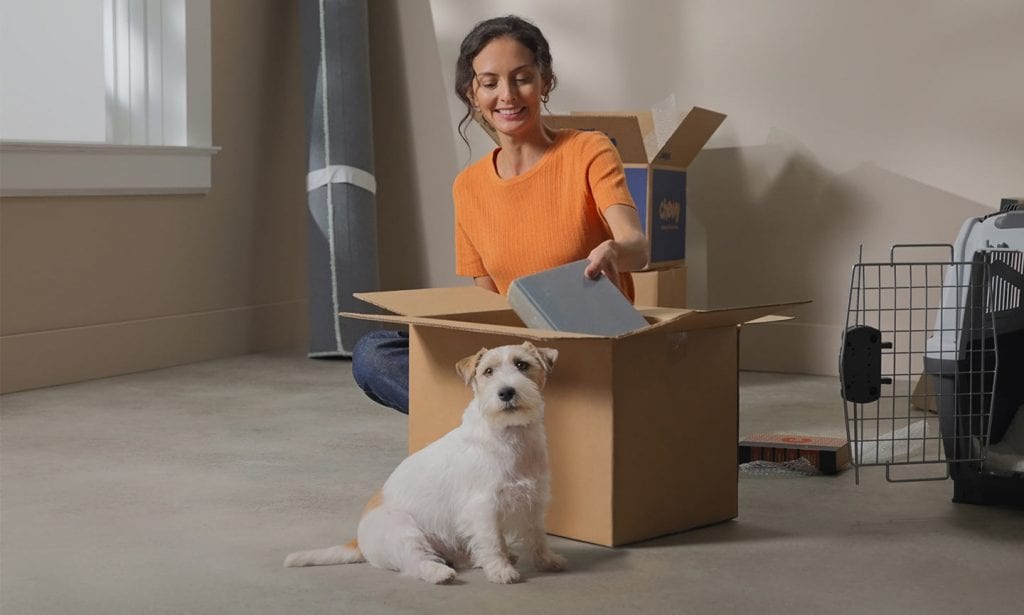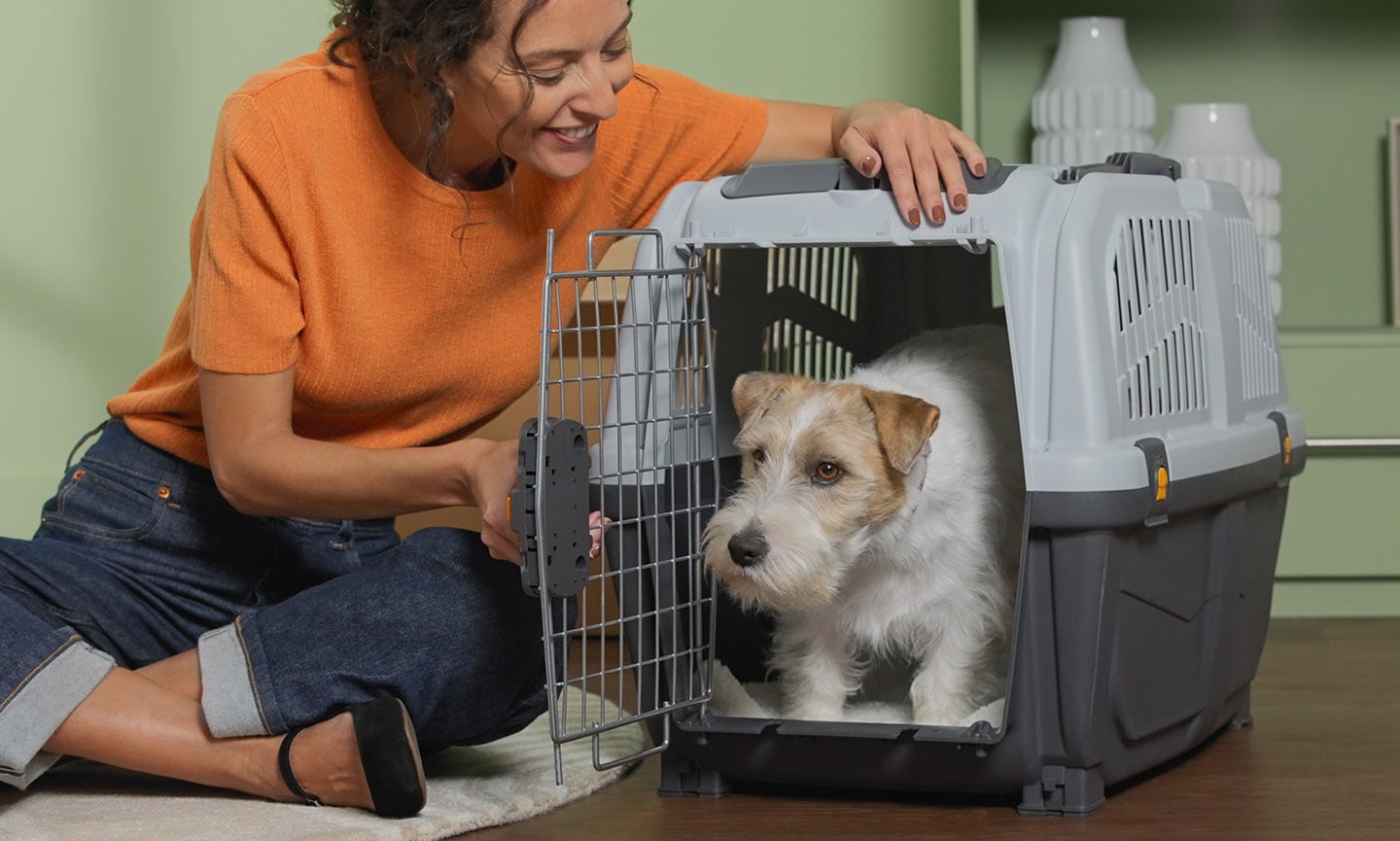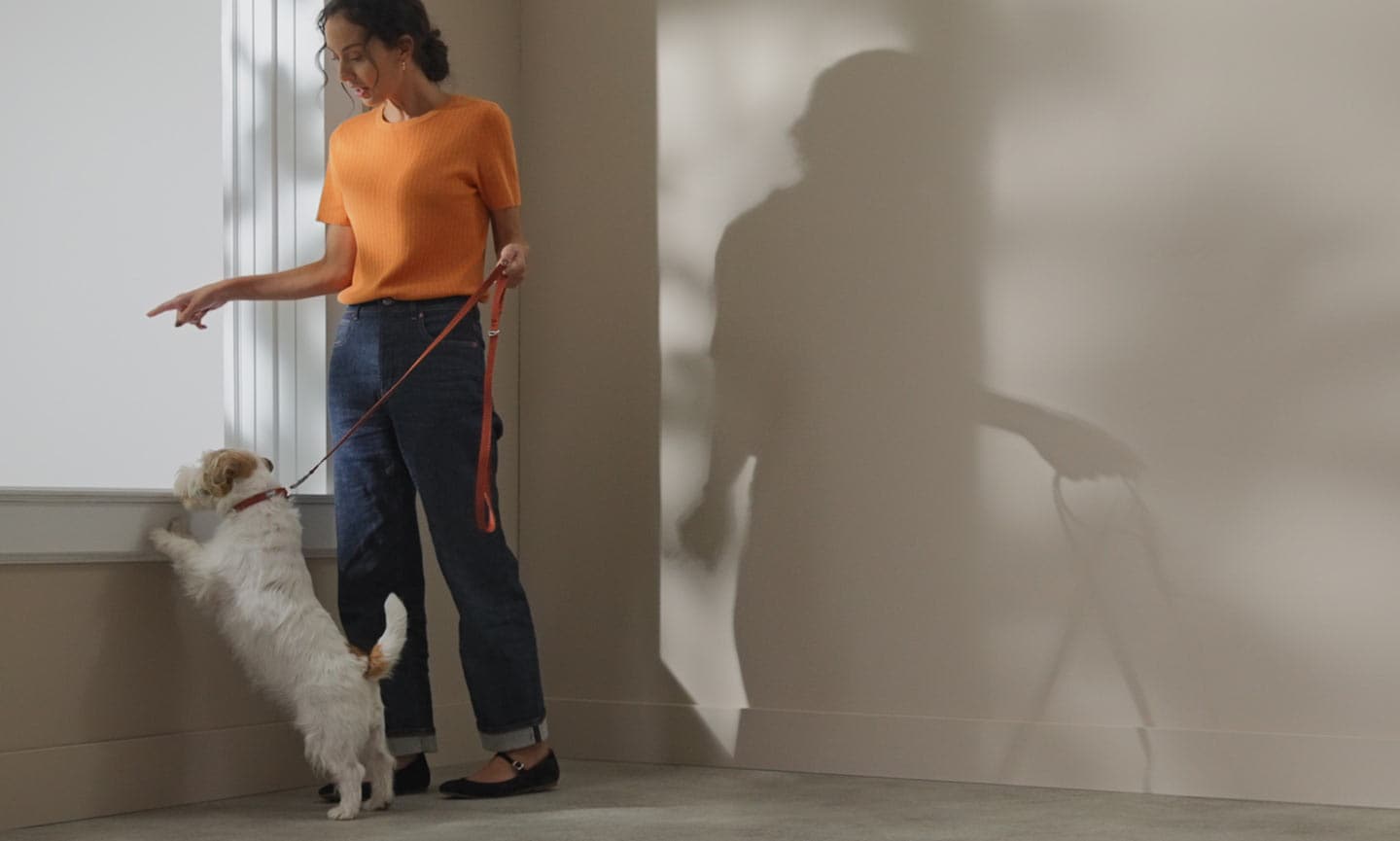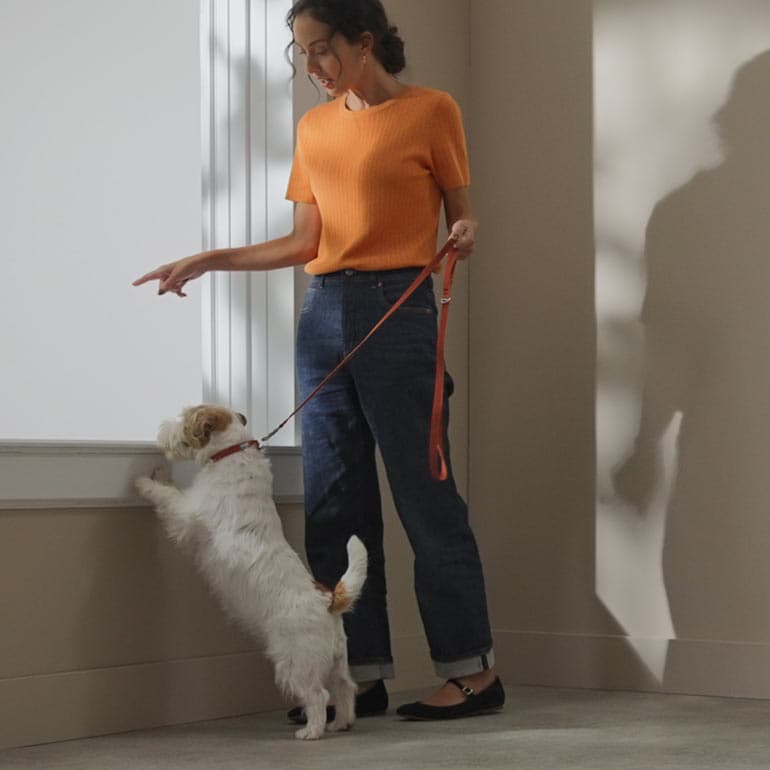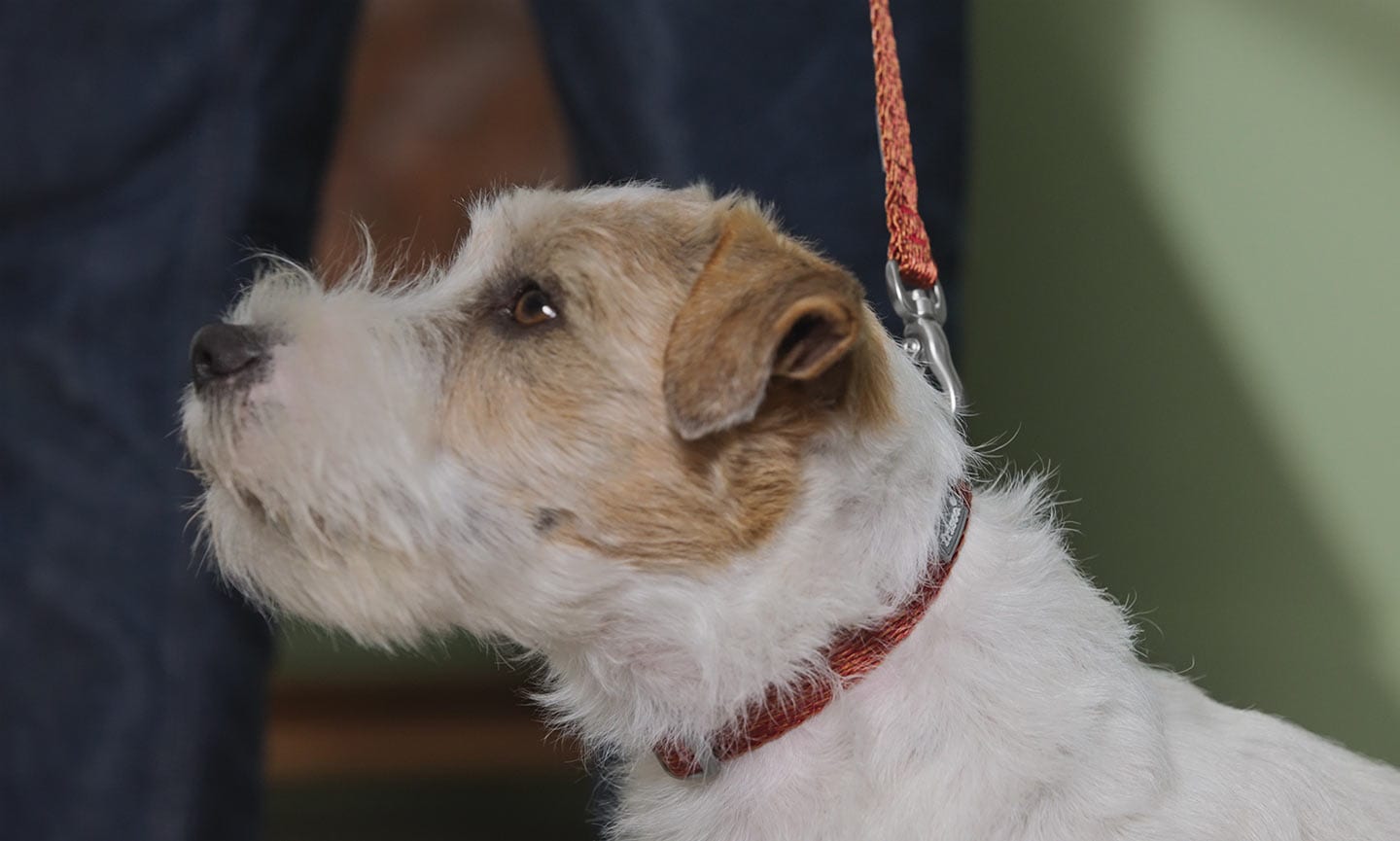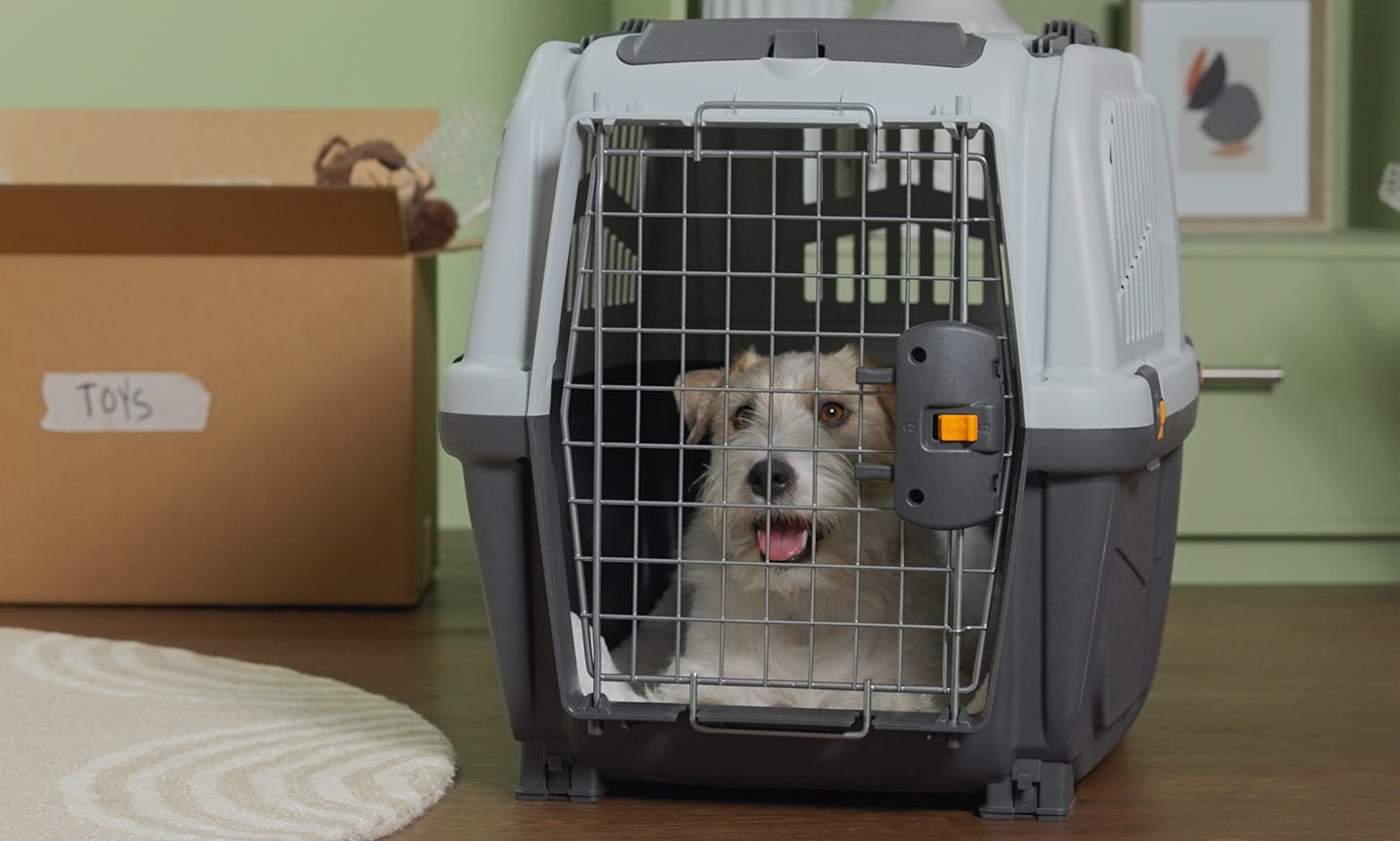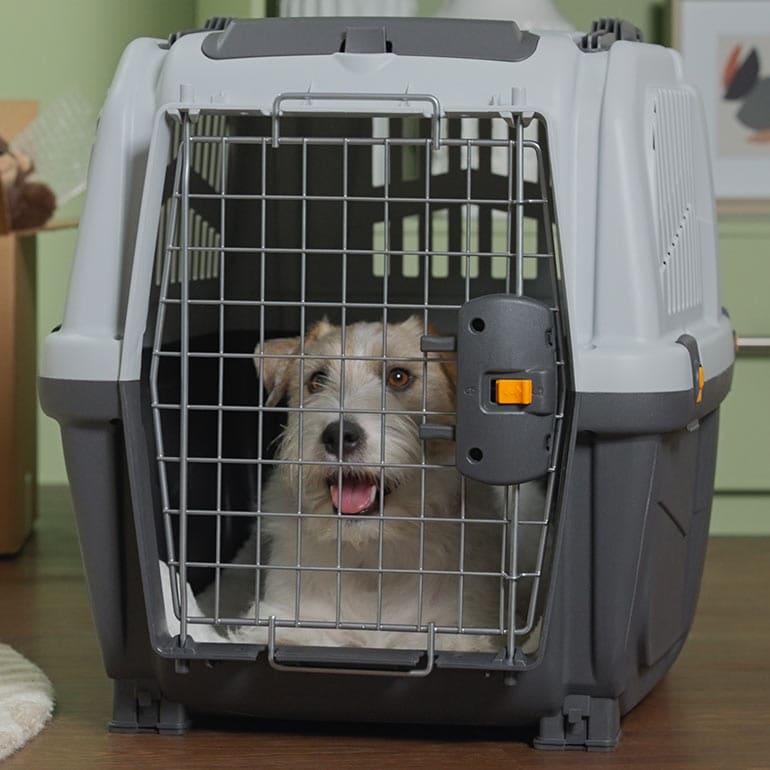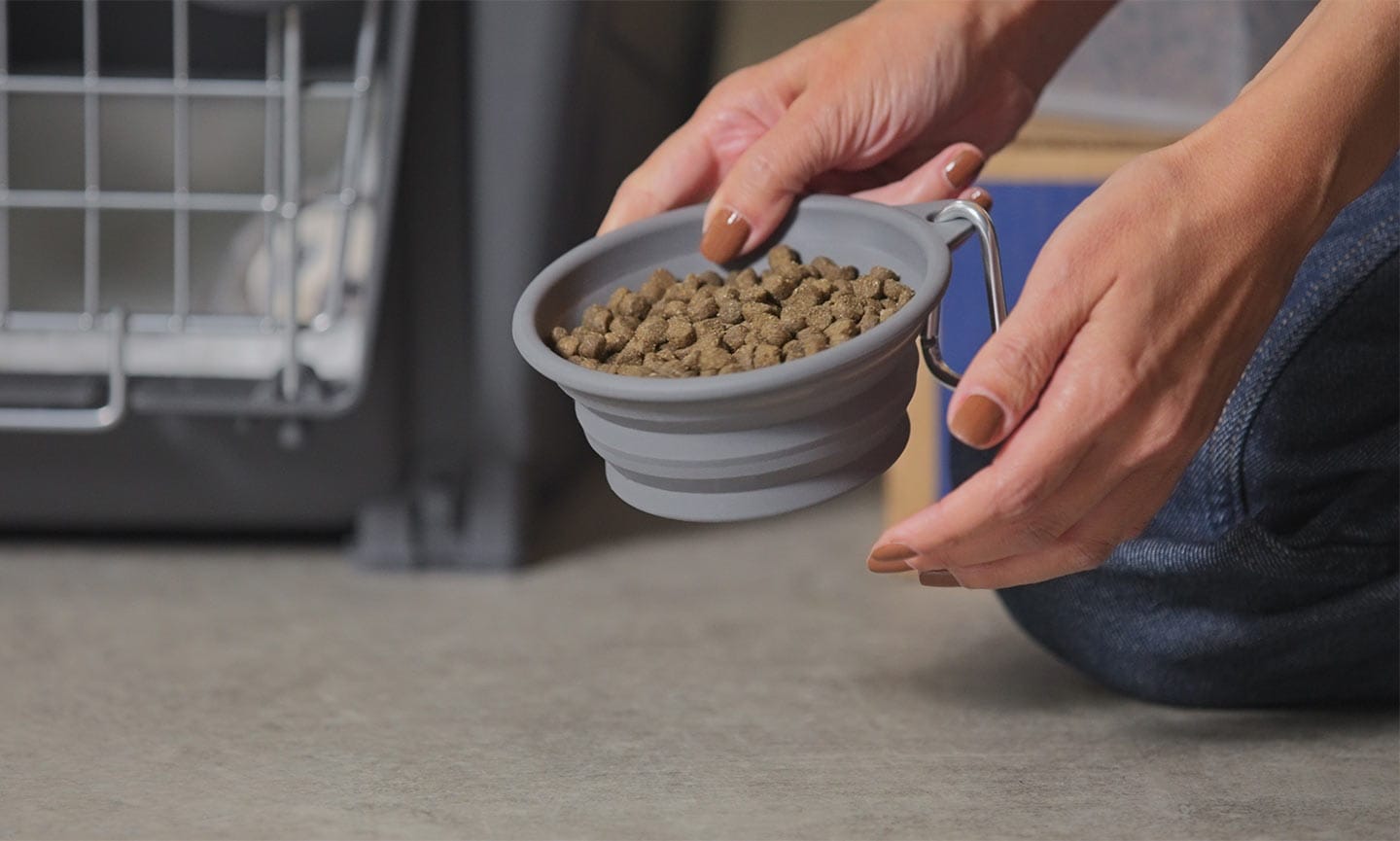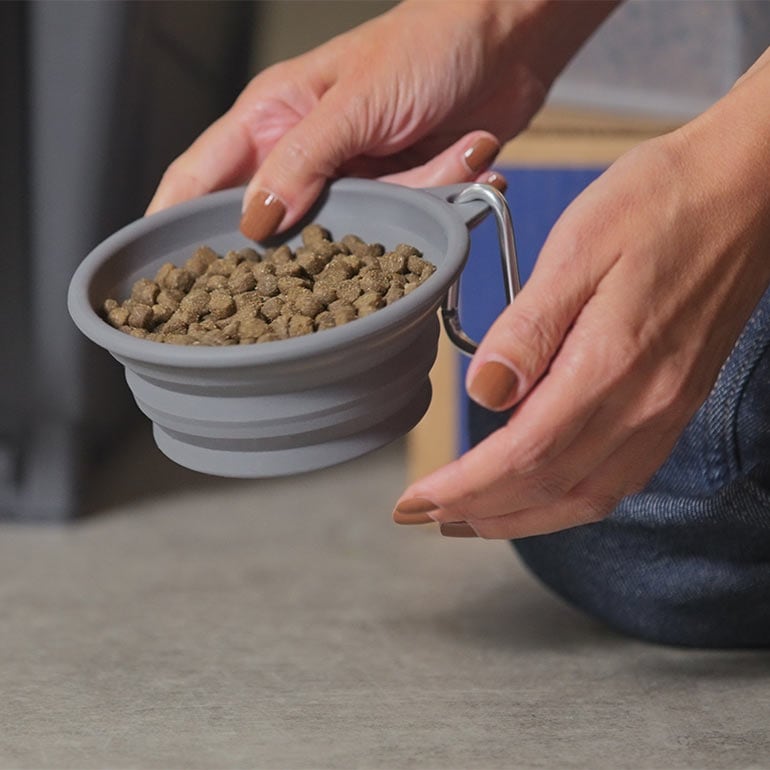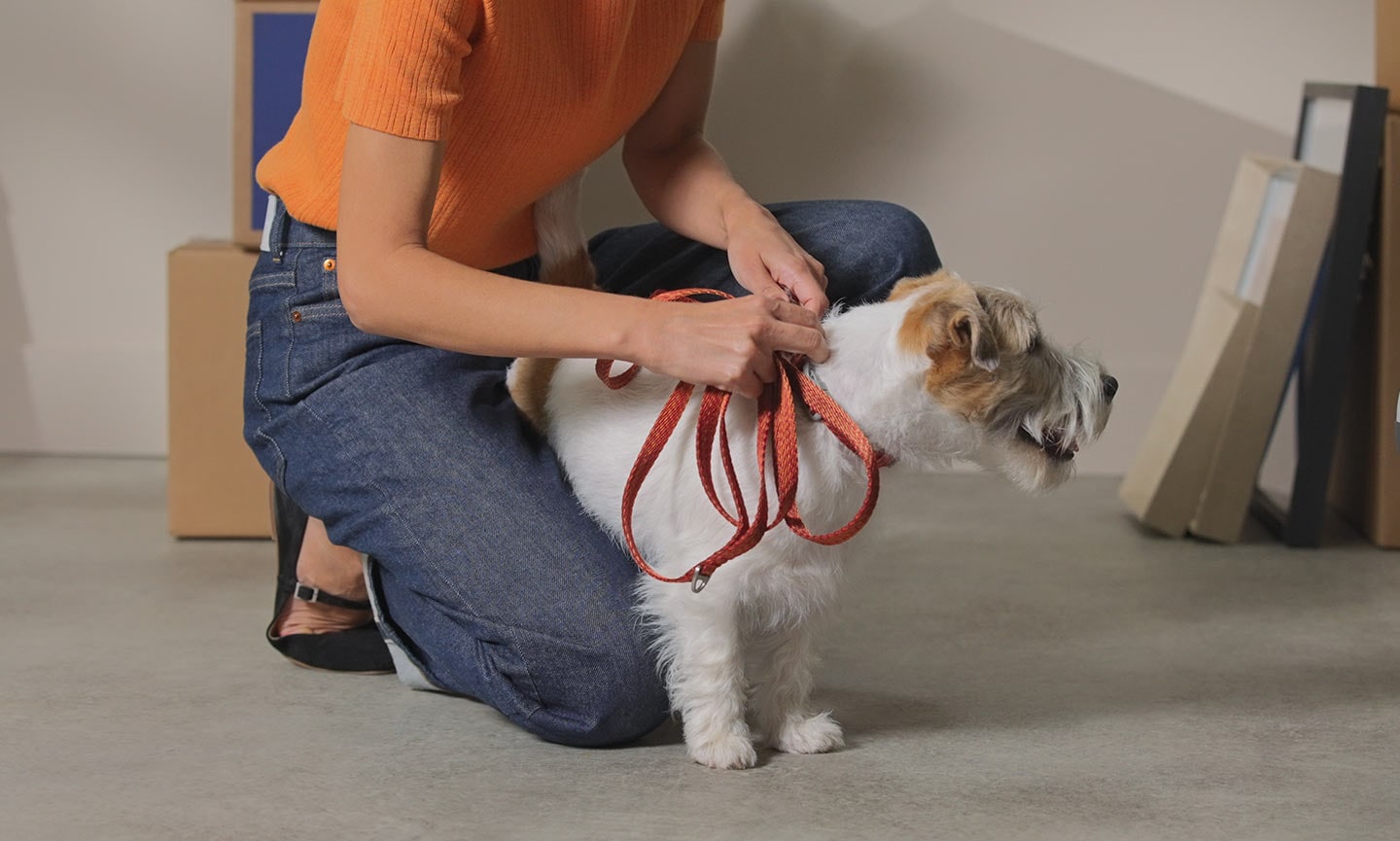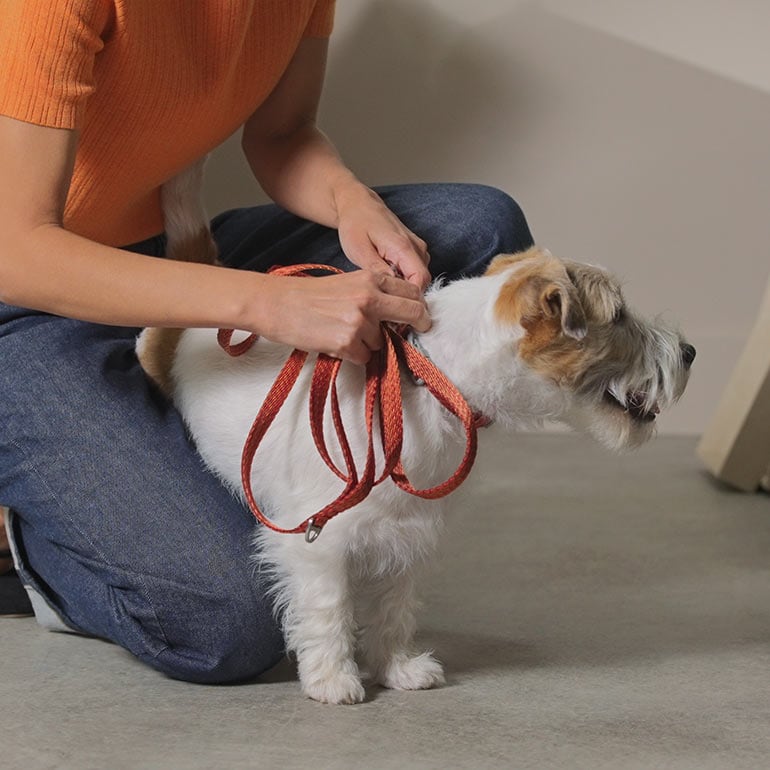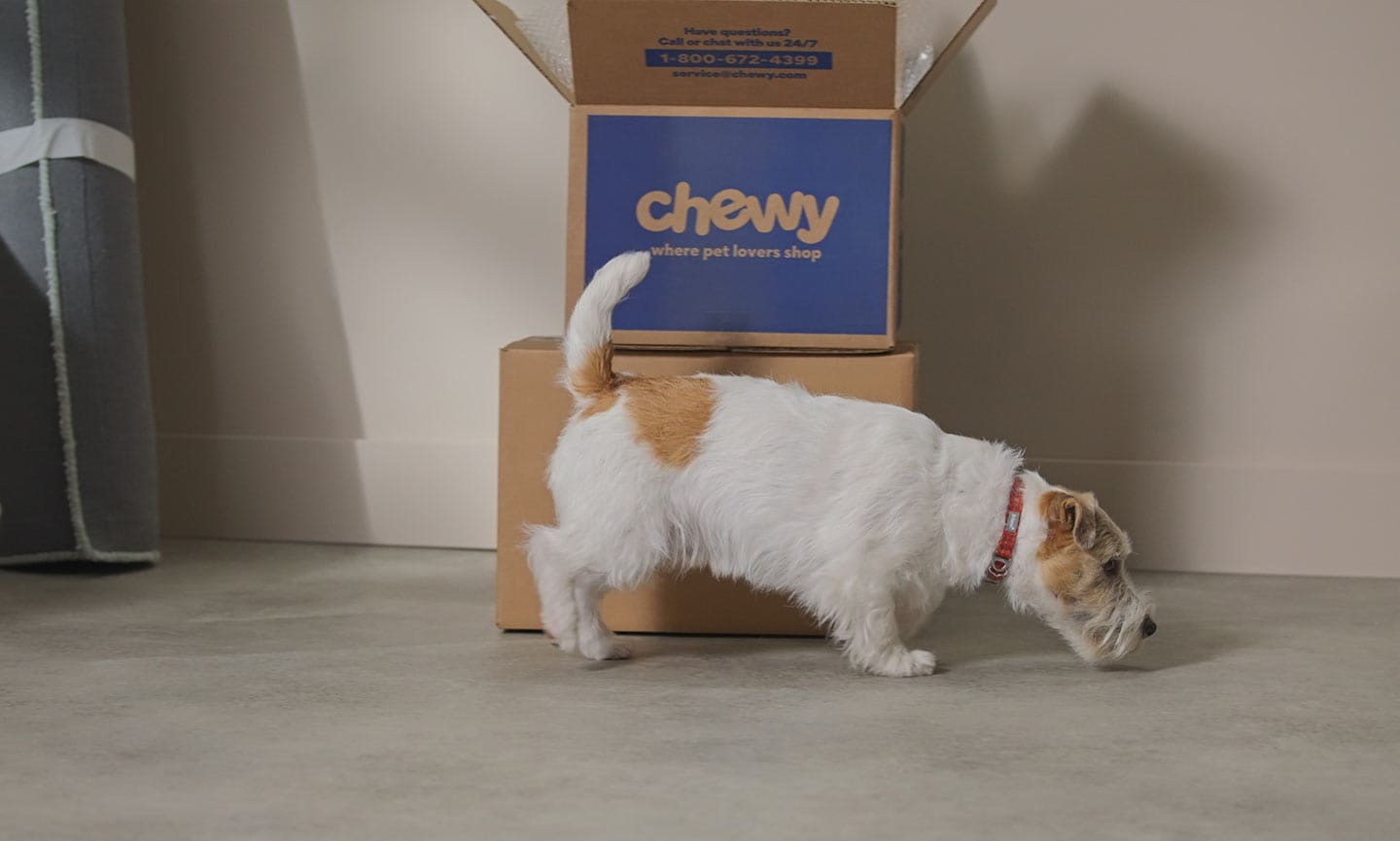Moving with dogs can be stressful—for everyone involved. There are all kinds of moving parts (no pun intended), ranging from managing your pet’s anxiety to finding a new veterinarian to making sure everything’s ready to go in your new home.
But here’s the good news: There are some things you can do to keep the process stress-free—or, at least, to go a little more smoothly. Below we’re outlining some of the common issues people run into when moving with dogs (and what to do instead), products to keep on hand, and a helpful guide on introducing your dog to a new house or apartment.
Click the buttons to jump to each section:
Moving With Dogs: Common Hazards
You know how stressful moving can be for you? Dogs can find it just as difficult. Dogs are creatures of habit, so when their environment or routine changes, their behavior often does too—sometimes in unwelcome ways. Plus, new places often present new safety risks for our pets.
These are the most common issues when moving with pets—and what you should do about them:
Dog Anxiety and Stress
Dogs are very much creatures of habit and routine. When you take them out of that routine, sometimes that can cause stress or anxiety. Signs of stress include:
- Barking
- Whining
- Excessive panting
- Not being able to settle down
Dog depression after moving can also occur, which can have similar symptoms. They may also experience reduced interest in their favorite things, a change in sleeping habits, and more lethargy.
There are many different ways to treat dog anxiety, including medications, supplements, and behavior management plans that work to desensitize dogs to their anxiety triggers. A combination of multiple treatments is often the most successful. Find out more about how to calm dogs with anxiety, and talk to your veterinarian if these symptoms persist longer than three or four days.
Motion Sickness
Whether you’re traveling by car, train or plane, your dog might experience motion sickness. You can be prepared for this possibility by talking to your veterinarian in advance of your move. Depending on your pet and their unique health needs, your vet may be able to prescribe medication to ease their nausea. Even if they don’t end up needing it, it’s nice to have that peace of mind—and you’ll be extra happy you have it if they do suffer from motion sickness.
Digestive Issues
Your dog might experience vomiting, diarrhea or constipation when moving. This can be caused by various factors, including stress, motion-induced nausea, more/less food and water, and a change in their potty routine. Talk to your vet about what to do if you encounter these symptoms—mild ones are likely to pass quickly, but more extreme issues could be cause for a vet visit.
Destructive Behavior
Stressed pets navigating unfamiliar situations may exhibit unwelcome behaviors, such as:
- Chewing
- Scratching
- Jumping
- Barking
In the short term, keeping your pet in their crate (if they’re properly crate trained) or another calm, dog-proofed area can mitigate these behaviors. In the long term, training and anti-anxiety techniques may be needed.
Safety Hazards
There are a few safety considerations to keep in mind when moving with pets. These include:
- Keeping your dog secure: Many dogs are prone to running away when they’re stressed, so it’s important to keep them safely contained, whether it’s on a leash, in their carrier or in a pet-safe room.
- Avoiding environmental hazards: Unfamiliar territories often come with different animals, plants, debris and other things your dog may want to explore—and not all of them will be safe for them to touch or ingest. You’ll need to stay alert and keep your dog away from anything you’re not sure about, including:
- Other pets in the neighborhood
- Plants you don’t recognize (especially if your dog has a habit of eating grass and other plants)
- Cans or broken bottles along the street or sidewalk
- Local wildlife that might pose a threat to your dog, such as birds of prey, snakes and raccoons.
Supplies for Moving With Dogs
Knowing how to move with pets means having all the right supplies on hand. Make sure you’ve got the following ready to go in advance.
- Dog carrier (should be large enough for them to stand up and turn around in. If flying, it should be approved by TSA)
- Food and water
- Portable food and water dishes
- Motion-sickness medication (optional—speak to your vet)
- Stress-relieving supplements or medication (optional—speak to your vet)
- A favorite toy, blanket or other comfort item
- Leash
- Dog treats
- Dog first aid kit, like the Pet Evac Pak First Aid Kit. This kit should also include their microchip number, health records paperwork and any medications they take regularly.
How To Introduce a Dog to a New Home
The process of introducing your dog to a new home has three key phases: pre-move, the move itself, and post-move. Here’s how to navigate each phase.
Before Moving
Before moving with your dog, do the following:
1 Take time to familiarize your dog with their crate.
Crate training gives your dog a safe space where they can comfortably chill. That’s likely to come in handy a lot throughout their lives, and it’s especially useful when you’re moving. So if you haven’t already, begin the crate training process now. Here’s how it’s done.
If your dog has both an at-home crate and a kennel for traveling, it’s a good idea to repeat the steps of crate training with their kennel, too, to reinforce those happy, zen vibes of having their own space while they’re on the go.
2 Research vets in your new neighborhood.
If you’re relocating a long distance, locate a veterinary office in your new locale ahead of time, and make sure they’re taking new pets. Here’s how to find a 5-star vet in your new area.
Now is also a good time to check in with your current vet. Depending on your dog’s unique health and personality characteristics, they may need medical support at certain points throughout your move. Meet with your veterinarian to discuss supplements and medications for stress, motion sickness and other concerns.
It's also a good idea to ask your current vet to renew your dog’s prescriptions for any medications or prescription foods that they regularly need. You should also find out what vaccinations are required in the state, city or town where you’re moving, and ask your vet to administer them (and make sure you get proof of vaccination afterwards, too).
3 Put together a doggy kit.
You’re going to need lots of gear on the move, and it’s useful to have everything in one place so you can find it easily. Essential items for your doggy kit include:
- Food
- Water
- Dog bowls
- Medications
- Leash
- Dog poop bags
- A first aid kit
- Dog toys
- Dog treats
- Pet wipes for messes
Make sure you have enough supplies for one to two weeks, so you’re not stressed about finding supplies in moving boxes.
4 Scope out the new neighborhood.
If you’re moving a shorter distance, bring your dog over to the new address a few times before the actual move to help familiarize them with the space. If you can go inside the home, that’s ideal; if not, it’s still helpful to sniff around the front yard and surrounding neighborhood to help them get used to their new digs.
On Moving Day
It’s time for the big move! Keep these tips in mind during the moving process:
1 Take frequent breaks.
2 Choose a safe, serene holding space for your dog.
During the transition from old home to new, you’ll want your dog tucked safely away from the mayhem (and closed off from any escape routes).
Choose a quiet area of your house, away from the movers, to confine your dog in their crate or kennel; alternately, you can use a small, dog-proofed room such as a guest bathroom. The key is to ensure there are no unlocked doors or windows in the room that your dog could use to escape; and, of course, to dog-proof the space to ensure they don’t make a mess of your new home on Day 1. Make sure to provide lots of busy toys and comfort items to entertain and soothe them during all the new, potentially scary noises that can come with unpacking boxes and moving furniture around.
As an alternative, consider sending your dog to day care or a boarding kennel, or ask a trusted friend or family member to watch them on moving day, especially if they’re uncomfortable with unfamiliar people in the house.
After the Move
After the moving company has left and you’re beginning to settle into your new abode, the following steps can help make the transition seamless:
1 Maintain their normal schedule.
2 Explore the neighborhood.
The first few walks in your new area are a time to allow your dog to explore with their nose. It’s OK to let them meander and investigate all the new smells during your first several walks—it’s all about making a positive association with this uncharted territory.
But remember that new areas can come with new safety hazards, so keep them on a short leash and be mindful of your surroundings and potential triggers for your dog, such as new animals or strangers.
3 Keep a close watch on your dog.
When it comes to giving your dog unsupervised access to the house and yard, go slowly. Giving them free-range right away can work for some dogs, but others may require a more cautious and careful approach to help ease them into their new space.
If you’re unsure how your dog will behave when you’re not watching them, start by leaving them alone for just 5 minutes at a time. After a few sessions, work up to 10 minutes, then 15, and so on until both you and your dog are comfortable spending time apart in your new place. Between sessions, make sure your dog is crated or secured in a safe, pet-proofed area.
When to Consult an Expert
There are a few scenarios in which you may want to reach out to an expert when moving with your dog:
- If your dog is anxiety-prone. Certain medications can help ease their emotional discomfort. Talk to your vet.
- If your dog has medical considerations that make traveling difficult. Your veterinarian can assist here, as well.
- If your dog won’t eat or drink in their new home. Dehydration and malnourishment are serious issues for dogs, so contact your vet immediately if you notice these signs.
- If your dog exhibits unwelcomed behaviors that you struggle to mitigate, such as destruction, biting, and barking. A veterinarian, trainer or behaviorist can help identify the cause of the behavior and create a plan to reduce or eliminate it.
Moving With Dogs: FAQs
Q:Is moving stressful for dogs?
A:Just as travel is stress-inducing for humans, it can also be pretty stressful for dogs. Changes in environment are generally difficult for dogs, who are creatures of habit and routine. In the same way some people are better/worse travelers than others, some dogs may feel more or less stressed than others.
Q:How long does it take for a dog to adjust to a new home?
A:This depends on the dog’s personality. Some dogs adjust within a few hours of getting to their new place while others can take weeks or longer. If your dog is struggling to adjust for more than a couple weeks, contact your veterinarian.
Q:Can dogs get sad after moving?
A:Yes, dog depression after moving can happen. Signs of dog depression include reduced interest in their favorite things, a change in sleeping habits, whining, barking, and lethargy. Some might have other personality shifts, like becoming more aggressive or barking more.
Q:How can I make moving with my dog easier?
A:One of the best ways you can make moving with dogs easier is keeping their routine as consistent as possible. Try to stick to the same foods and eating times, and take the same number of breaks and walks. It’s also important to prepare for the move in advance, which includes speaking with your current veterinarian (and new one if necessary), familiarizing your dog with their crate, and packing more than enough supplies for your journey.
Ready to move? Get more tips to keep your pet happy along the way:
Share:
